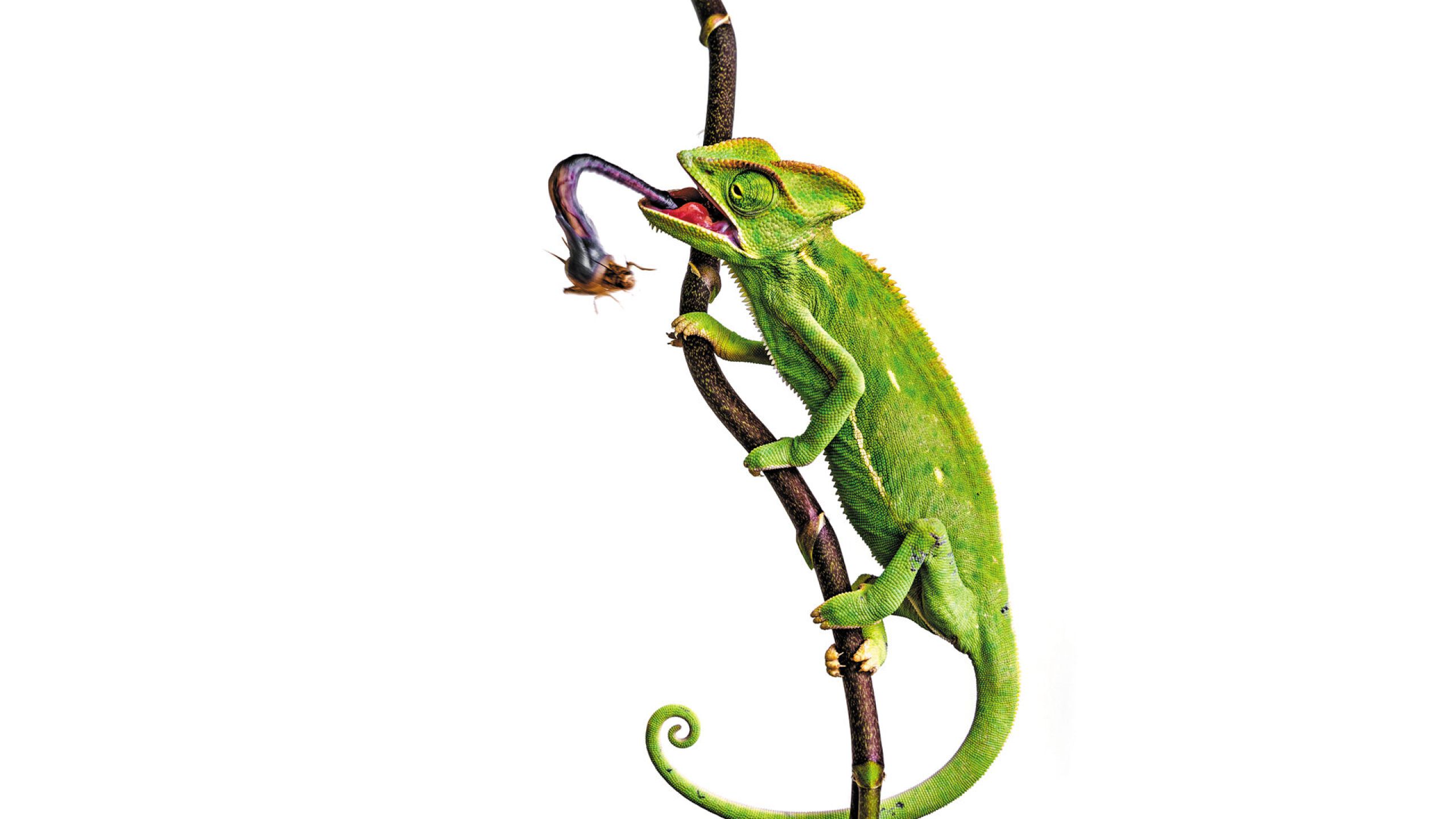The Tongue – Not a Thing to Underestimate!

In This Article
-
The remarkable diversity in animal tongue morphology underscores the intricate design and adaptation evident in all of creation, suggesting a divine understanding of each creature's unique characteristics and the provision of suitable organs to match their needs. Nearly eight thousand species of salamanders and frogs, chameleons and many lizards quickly pull their prey into their mouths by throwing their tongues like ballistic missiles to hunt. Chameleons, for example, catch crickets in less than a tenth of a second by propelling their tongues at a speed close to five meters per second.
-
The tongue is the most vital organ for animals which feed on nectar, such as hummingbirds. Their tongues are created to suck high-energy nectar from the depths of the flowers, like a straw.
-
When they focus too much on what they are doing with their hands, we can see that some people unconsciously open their mouths and move their tongues left and right with a certain rhythm. Some scientists do not see this as an oddity and say that these tongue-twisting movements can increase the accuracy of movements in delicate manual work.
Countless studies, books, and articles have explored the taste, swallowing, and speech capabilities of the human tongue, often regarded as merely a small piece of flesh. One significant distinction between humans and animals lies in our ability to utilize the tongue for language, a capacity not shared by animals. However, what other roles might animal tongues serve?
Suitable for nutrition
The tongue, found in the vast majority of vertebrate animals (with the exception of a small group of frogs), possesses a remarkable flexibility owing to the arrangement of its muscle fibers in a multidirectional web. The variety of tongue structures across animal species reflects differences in their habitats, dietary habits, and lifestyles. It is crucial to note that for most terrestrial vertebrates, survival would be severely compromised without their tongues. In aquatic environments, where food tends to be softer and readily digestible, tongues aid in biting and mixing food with digestive enzymes. Conversely, the multitude of solid and dry foods found on land, including fruits, vegetables, and animal source foods, require soaking and softening for digestion. Animals thus necessitate tongues created in the best convenient form for their body structures and dietary needs to effectively consume such diverse foods. The remarkable diversity in animal tongue morphology underscores the intricate design and adaptation evident in all of creation, suggesting a divine understanding of each creature's unique characteristics and the provision of suitable organs to match their needs.
Fish species like carp and catfish lack a mobile and extensible tongue, instead possessing a muscular bundle known as the palate. Unlike humans, fish don't require mobile tongues for swallowing food. They open their jaws wide to expand their throats and pump water through their gill slits forming a bellows-shaped mechanism that generates a powerful suction force, enabling them to swallow food effortlessly without the need for a moving tongue to assist in biting.
In contrast, land animals lack a bellows-like mechanism such as gills to facilitate food swallowing. While they could potentially use air instead of water for suction, air lacks the density to generate a comparable swallowing force. Instead, they are given the tongue, an organ equipped with robust muscles. However, some birds, due to the slender structure of their mouth and neck regions, cannot accommodate a thick tongue. Instead, they have been taught to swallow by utilizing gravity, keeping their heads raised.
The need for food is one explanation among many as to why tongues are in so many different forms, structures, and functions. Some species of salamanders have a sticky tongue which is longer than their body; they catch insects by snapping their tongue at its prey like a whip. Webbed salamanders (Hydromantes) protrude their attached throat skeleton from their mouths, along with their tongues, which is covered with a sticky secretion, to catch insects or spiders. The tongue is then refolded in its former place in the throat with a special mechanism, where it stores energy for a while to be ready to catch the next prey.
Nearly eight thousand species of salamanders and frogs, chameleons and many lizards quickly pull their prey into their mouths by throwing their tongues like ballistic missiles to hunt. Chameleons, for example, catch crickets in less than a tenth of a second by propelling their tongues at a speed close to five meters per second. These tongues are covered, of course not coincidentally, with very small lumps called papillae, which produce a sticky secretion. The secreted saliva is so sticky that the prey, even if it is 50% heavier than the hunter, cannot save itself from it [1].
Horned lizards (Phrynosoma) use their sticky saliva-covered tongues not only to catch prey, but also to protect themselves from the possible danger of their prey. Ants, which are the prey of these lizards, have poisonous and strong bites. However, despite this, horned lizards swallow them alive. In a 2008 study, it was discovered that the dense and sticky slimy substance secreted from the blister-shaped glands on the tongues and throat walls of lizards protects the lizard from the venom of ants [2].
Some animals, such as the mace-headed giant gecko (Rhacodactylus auriculatus) that lives on the island of New Caledonia, use their tongues to clean their eyes. Snakes sniff their surroundings with their forked tongues, that is, the tongue of snakes is the organ of smell, not the organ of taste. The vibrational frequency of their tongues, which are created to locate their distant or hidden prey, varies according to the intensity and distance of the smell. In order to understand the nature of the odor molecules that stick to their tongues from the air, snakes insert their forked tongues into the Jacobson's organ in their upper palate so that the smell is perceived in their brains. It is amazing that they are created with this mechanism and taught to follow this procedure.
Bird tongues are like surgical instruments of specialist doctors so that they can benefit from different food sources. An important factor in the diversity of tongues in birds is related to the shape of the flowers, which carry the sweet nectar of the plants. The tongue of most birds is made of very little muscle and connective tissue and is covered with a keratin cover. Attached to the root of the tongue is a system of levers made of bone which is tasked to function like a production line, moving the tongue back and forth so the food is transported from front to back. The woodpecker, for instance, inserts its bill into tree cavities and use their specially structured tongue to pull insect larvae into their mouths.
The tongue is the most vital organ for animals which feed on nectar, such as hummingbirds. Their tongues are created to suck high-energy nectar from the depths of the flowers, like a straw. Nectar is easy to find, but the tongue needs to be suitable for the unique structure of the flower. This is of vital importance so the birds can get a drop of nectar at the bottom of these flowers, which are usually long and narrow-throated.
Previously, it was thought that the nectar passively rose up the round and thin straw-like bills with a capillary mechanism. However, research has shown that, contrary to previous understanding, nectar is collected into the grooves on the tongue through the broom-like end, as observed in the Pied Honeyeater (Certhionyx variegatus). It’s been found that the physical capillarity is not fast enough to drink the nectar of flowers, so hummingbirds move their tongues 15 times per second while hovering, running their tongues back and forth like the piston of a pump [3].
We see that not all nectar-feeding birds are like hummingbirds, and that each bird is equipped with a bill and tongue structure suitable for its food. The tongues of the lorikeet (Trichoglossus moluccanus), who are members of the parrot family, are similar to those of humans, but with their fleshy-looking tongues with brush-like tips, they collect nectar from long-necked flowers by turning it into paste. Unlike the lorikeet, which has a brush-like tongue tip, other species of parrots have a grooved tongue tip to collect nectar; their tongues vibrate very quickly to pump nectar into the esophagus [4].
The tongue and hand skills in humans
Xu An, a neurobiologist at Duke University, and his colleagues have discovered an area in the monkeys' cerebral cortex called the "oromanuel" region that exerts control over both hands and tongue. There are observations suggesting that a similar brain region exists in humans. For example, as the fingers of children who learn to write move, so does their tongue with similar curves. When they focus too much on what they are doing with their hands, we can see that some people unconsciously open their mouths and move their tongues left and right with a certain rhythm. Some scientists do not see this as an oddity and say that these tongue-twisting movements can increase the accuracy of movements in delicate manual work. However, it is difficult to observe this situation because most people have their mouths closed.
By examining the neural activity records in monkeys, information was obtained about how the complex tongue movements involved in feeding, drinking, and perhaps even vocalizations are coordinated in the brain. It has been determined that in a region the size of a penny in the cortex, there are both sensory neurons coming from the tongue and mouth, as well as movement (motor) neurons that are instrumental in controlling tongue movement. In addition, while it was once thought that chewing movement was under the control of the brain stem just as, for instance, walking is, it has been shown that this center occupies a lot of space in the cerebral cortex, and that the curving of the tongue in complex and asymmetrical ways according to the type of food at the time of chewing is controlled very quickly from here.
Tongue saved from teeth
The most important function of the tongue in mammals is to position food so it is properly chewed and swallowed. Have you ever thought about how agile our tongue must be to stay between our teeth and not get bitten when we talk or chew food? Depending on the species, it takes great timing to shift the food from one side of the mouth to the other with each bite, or to limit it to just one side, keeping the tongue itself safely away from the teeth so that it can't be bitten. Then, with the addition of secreted, slippery, and softening saliva, the tongue, with appropriate movements, forms the food into a round bite that can easily pass through the throat. Finally, when pushing this bite into the esophagus to be swallowed, a precise adjustment is observed so that not even a small piece escapes into the airways.
Shape and volume ratio
The human tongue, like a water balloon, is a muscular hydrostat whose total volume of mass must remain the same, no matter how much its shape changes. Therefore, when we stick out our tongue, it becomes thinner and longer compared to its bulk shape in the mouth. Similar movements apply when the giraffe's purple-colored tongue which extends 45–50 cm outward to collect leaves from a thorny tree branch.
In addition to functions such as assisting in eating and distinguishing between thousands of different tastes, the human tongue is unique in helping us speak our complex languages. This is possible because of our tongue’s ability to change shape easily. For the tongue to instantly convolute according to the thousands of words formed in the mind and send food to the pharynx without being bitten, there must be centers in the brain with very different and complex neuron units. The brain is responsible for adjusting all body behaviors by informing other parts of the brain about the processes in these centers. For example, the management of hundreds of functions, such as grimacing because of a sour taste or the immediate reflection of a sudden change in our thinking while speaking and in our choice of words seem to be under the control of neurons in these centers. Looking at these amazing activities, one surely seeks a source of power and wisdom beyond biological structures – neurons or otherwise – that can command all the nerves and atoms in our body.
In all species, the tongue is equipped with taste buds in order to be able to "gate" in directing nutrition and to understand the nature of food. All these special skills given to the tongue enable mammals to eat more food faster and in greater quantities than other vertebrates and to digest this food efficiently. Thanks to this feature given to their tongues, mammals can have their high metabolic rate and activity, both the mother and offspring can be nourished during long-term pregnancies, and the energy needs of large brains are met.
The tongue, which is braided by a complex network of muscle fibers that can move in complex ways, contributes to sucking in most species, but in others, such as dogs, it helps thermoregulation (heat regulation). The excess heat of their bodies, which get very hot by running, is cooled by sticking their tongues out. Bats, on the other hand, click their tongues to produce sounds that are used for echolocation (locating and locating by sound).
A home for microbes
Our tongue is also home to a complex community of bacteria that can affect our health. According to Jessica Mark Welch, a microbial ecologist at the Forsyth Institute, the tongue is an unknown and very important part of the human microbiome as an important source of bacteria. Welch says that the proportions of these microbes vary from person to person, but each bacterial community may have a specific function. For example, the bacterium called Veillonella on our tongue contributes to the regulation of blood pressure by performing the function of converting nitrate to nitrite, which the human body cannot do without. Other bacteria are also thought to possibly play a role in regulating the immune system [5].
We started with a tiny piece of meat, but as we finished it, I hope we understood that our tongue, which is a miracle of creation, is not a small and simple piece of meat.
References
- C. A. Noel, D. L. Hu, “The tongue as a gripper”, Journal of Experimental Biology, 2018, 221/7, s. 1–10.
- W. C. Sherbrooke, K. Schwenk, “Horned lizards (Phrynosoma) incapacitate dangerous ant prey with mucus”, Jez-A Ecological and Integrative Physiology, 2008, 309A/8, s. 447–459.
- A. E. Hewes et al. “Variable evidence for convergence in morphology and function across avian nectarivores”, Journal of Morphology, 2022, 283/12, s. 1483–1504.
- A. Rico-Guevara et al. “Nectar feeding beyond the tongue: hummingbirds drink using phase-shifted bill opening, flexible tongue flaps and wringing at the tips”, Journal of Experimental Biology, 2023, 226 (Suppl. 1), s. 9356–9360.
- S. A. Wilbert et al. “Spatial ecology of the human tongue dorsum microbiome”, Cell Rep, 24 Mar 2020, 30/12, s. 4003–4015.









